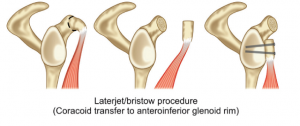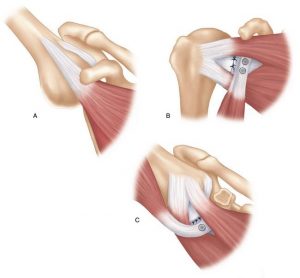Shoulder dislocation
The shoulder is a ball and socket joint. It has a huge arc of movement. This is because the socket is more like a plate than an egg cup. The disadvantage of this is that the shoulder can easily be dislocated with significant trauma.
When the shoulder is dislocated, the soft tissue structures, which hold the ball in the socket are torn or irreversibly stretched, and the shoulder then becomes too loose. Further dislocations can occur with minimal trauma.
Any person who has had two dislocations has a shoulder which is permanently too loose and will only really recover with some form of surgery.
In the past Mr Kurer used to a surgical tightening either by an open operation or as a keyhole procedure using keyhole stitching techniques.
This treatment seemed very effective but recently long-term follow-up studies beyond 6 years showed that a different operation, called the Latarjet procedure had better results. This is a completely different operation. Here, a piece of bone with tendons attached nearby, is released and transferred to the front of the socket. This makes the socket wider and also brings these extra tendons in under the shoulder to prevent dislocation


The operation is done as a day case through a 10 cm incision. The bone is screwed to the front of the socket bone, so it is a very strong repair and patients need only wear the sling for 3 weeks.
All patients return to the gymnasium at six weeks for muscle strengthening and to football at twelve weeks but are not able to resume rugby, tennis or over-arm swimming until six months after the surgery.
